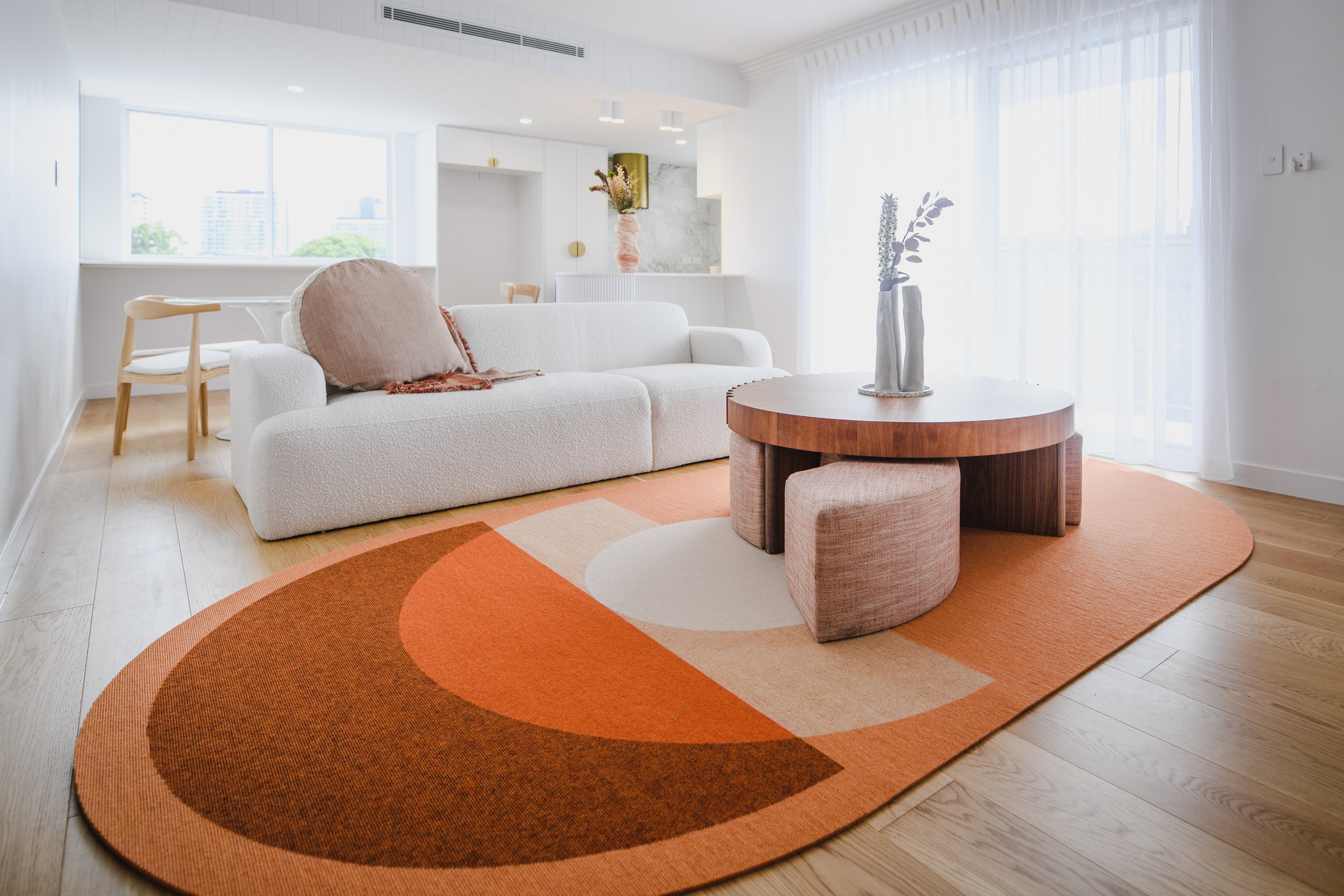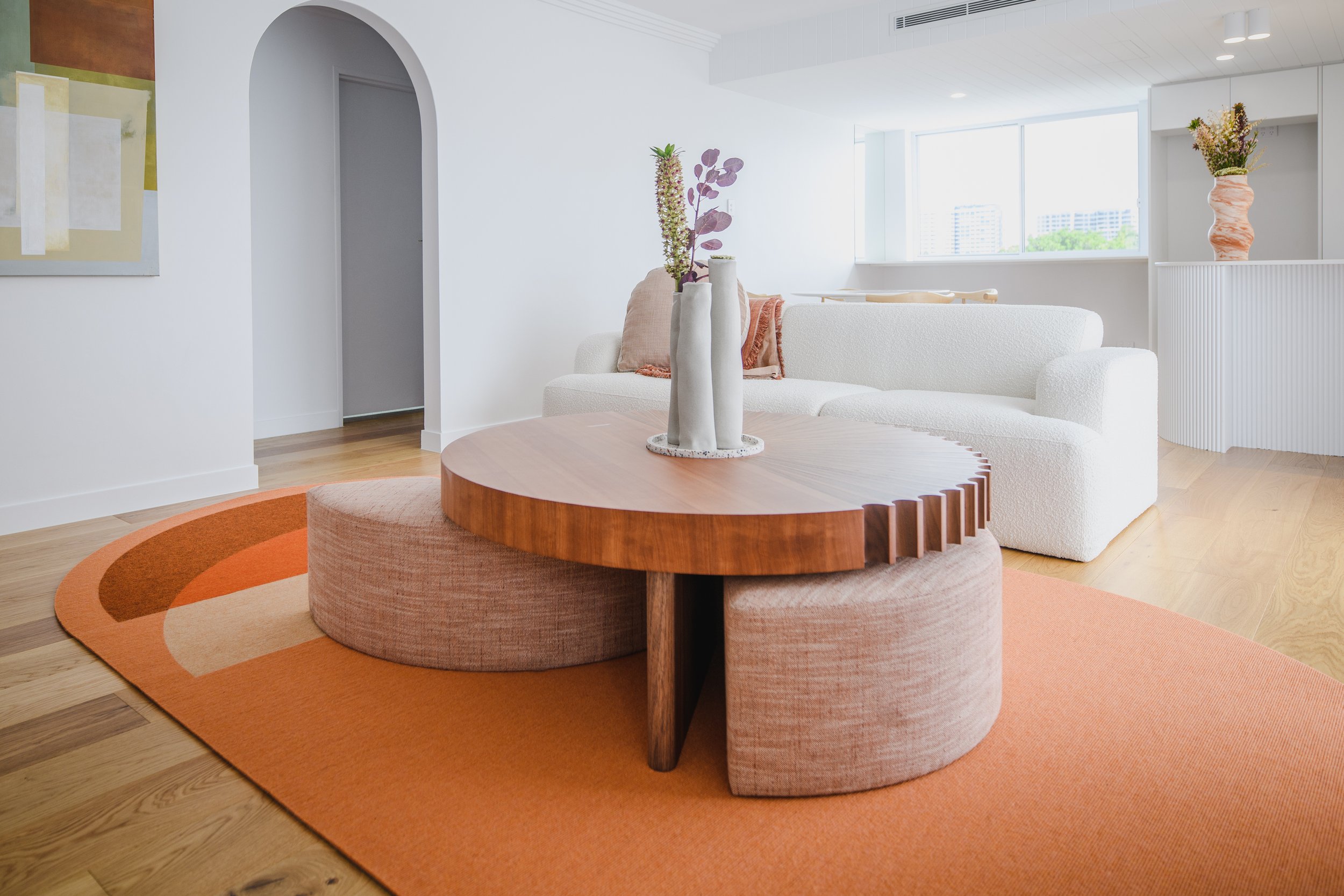
Zaha
Modern, luxurious and visually intriguing: exactly what you can expect from Markian.
Zaha echoes the curves and symmetry of the Vieira scallop. Rounded curves and semi-circles make a bold and inviting statement rug.
Made from tretford® (Mongolian cashmere goat hair), Zaha is soft and durable.
Customise Zaha to suit your space with your choice of Markian's nine colourways, designed to delight your senses and enliven your space.
-
Tretford Rugs by Markian are handcrafted and manufactured in Brisbane, Australia by joining colours from the Tretford ROLL carpet to create custom pieces.
Tretford carpet has exceptionally clean, elegant lines due to its unique construction using cashmere goat hair.
The natural properties of Tretford Rugs actively reduce airborne dust and allergens, promote energy-saving, and facilitate excellent indoor acoustics.
From the company’s foundation in the mid-1950s, Tretford’s focus has been utilising natural and renewable resources – which in today’s terminology means using sustainable raw materials.
Produced in Germany and Ireland for over 50 years, Tretford carpets positively contribute to healthy living and working environments. This is largely due to its unique feature, Cashmere goat hair from the highlands of Inner and Outer Mongolia.
Tretford Roll & INTERLIFE Tile largely consist of this long top hair of the Cashmere goat, and also other renewable and recycled raw materials, for example, jute in Roll format, and 80% recycled polyester felt in INTERLIFE tile backing. This unique construction – with its distinctive structural corded look and proven quality – has established Tretford as a much-loved brand around the world.
The Tretford Rugs by Markian range is an extension of the range motif and carries with it the playfulness of colour combinations, the stark graphic delineations that separate but join and the shapes that combine it all together.
-
75% New Zealand wool and 25% bamboo
Hand-tufted rugs are produced by shooting yarn through a tufting gun into a stretched fabric frame, much like a stretched canvas. Each shape and colour is tufted separately, like a colour-by-numbers, and their construction makes them the perfect choice for geometric designs. Hand-tufted rugs are more affordable than hand-knotted rugs, and their durability means they are suitable for commercial applications. Wool Valued for its durability and natural softness, sheep wool has been a staple of rug making for millennia. Its distinctive structure and lanolin content give it a number of important benefits – it is flame retardant, stain repellent, extremely durable and even acts as a natural dehumidifier.
Wool is also a 100% renewable product, making it highly sustainable and eco friendly. We use 75% New Zealand wool in our hand-tufted rugs.
Bamboo has been used in the rugs for a touch of shimmer and shine. The bamboo fibres add dimension, playing wonderfully with light and shifting constantly under the gaze. Bamboo has a lustre similar to silk and is used to emphasise portions of each rug’s design, creating incredible highlights and lowlights. We use 25% bamboo in our hand-tufted rugs
-
6-8 weeks depending on volume of order.
-
12-14 weeks depending on volume of order.
-
“I don't think that architecture is only about shelter, is only about a very simple enclosure. It should be able to excite you, to calm you, to make you think.” - Zaha Hadid.
Zaha Hadid was born in 1950 in Baghdad, Iraq, during a period of prosperity in which the government chose to invest in modernising the city's architecture.
Her childhood saw the completion of buildings by such iconic architects as Frank Lloyd Wright and Le Corbusier. Hadid's father, Muhammad al-Hajj Husayn Hadid, was a wealthy industrialist and politician who contributed to this progressive government impetus. Her mother Wajiha al-Sabunji was an artist.Hadid attended the American University in Beirut, Lebanon, where she earned a bachelor's degree in mathematics. In 1972, she moved to continue her studies at the Architectural Association in London, a centre of progressive architectural thought. She studied under Rem Koolhaas, Elia Zenghelis, and Bernard Tschumi, who all recognised her talent. Her former professor, Koolhaas, described her at graduation as "a planet in her own orbit." Zenghelis described her as the most outstanding pupil he ever taught.
Over the last two decades, her work has been honoured by a long list of awards: In 2004, she was the first woman to be awarded the Pritzker Prize; in 2010 and 2011, she received the Stirling Prize, a British decoration for excellence in architecture; in 2014 her Heydar Aliyev Cultural Centre, like an undulating sheet of graph paper, won the Design Museum Design of the Year Award; and in 2016 she became the first woman to win the RIBA Gold Medal.
Hadid’s projects, many of which transform depending on the viewer’s perspective, turn architectural convention on its head. The architectural style of Hadid is not easily categorised, and she did not describe herself as a follower of any one style or school. The Design Museum described her work in 2016 as having "the highly expressive, sweeping fluid forms of multiple perspective points and fragmented geometry that evoke the chaos and flux of modern life." Hadid described the essence of her style very simply: "The idea is not to have any 90-degree angles. In the beginning, there was the diagonal.
The diagonal comes from the idea of the explosion which "re-forms" the space. This was an important discovery.” Her untimely passing in 2016 at age 65 shocked the design community, and she has left an indelible mark on the architectural landscape.
Request a Quotes














